BTR-80
The BTR-80 (Russian: бронетранспортёр/Bronyetransportyor, literally "Armoured Transporter") is an 8×8 wheeled amphibious armoured personnel carrier (APC) designed in the USSR. It was adopted in 1985 and replaced the previous vehicles, the BTR-60 and BTR-70, in the Soviet Army.[3] It was first deployed during the Soviet–Afghan War.[4]
| BTR-80 | |
|---|---|
_(cropped).jpg) Russian BTR-80 | |
| Type | Armored personnel carrier |
| Place of origin | Soviet Union |
| Service history | |
| In service | 1986–present |
| Used by | See Operators |
| Wars | Soviet–Afghan War Nagorno-Karabakh War Georgian Civil War Kurdish–Turkish conflict (1978–present) Transnistria War Tajikistan Civil War War in Afghanistan Iraq War First Chechen War War of Dagestan Second Chechen War 2008 South Ossetian War Iraqi insurgency (2011–13) Sudanese conflict in South Kordofan and Blue Nile[1] War in Donbass |
| Production history | |
| Manufacturer | Arzamas Machine-Building Plant, Nizhniy Novgorod[2] |
| Produced | 1984–present |
| No. built | 5,000+ |
| Specifications | |
| Mass | 13.6 tonnes (15.0 tons) |
| Length | 7.7 m (25.3 ft) |
| Width | 2.9 m (9.5 ft) |
| Height | 2.41 m (7.9 ft) |
| Crew | 3 (+7 passengers) |
Main armament | 14.5 mm KPVT machine gun or 30mm 2A72 automatic cannon |
Secondary armament | 7.62 mm PKT machine gun |
| Engine | diesel KamAZ-7403 260 hp (190 kW) |
| Power/weight | 19 hp/tonne |
| Suspension | wheeled 8×8 |
Operational range | 600 km (372.8 mi) |
| Maximum speed | 80–90 km/h (49.7–55.9 m/h) swim 10 km/h (6.2 m/h) |
Description
The Soviets-based the BTR-80 on the BTR-70 APC. It has a single 260-hp, V-8 turbocharged, water-cooled, diesel engine, an improvement over the twin gasoline engines installed in the BTR-60 and BTR-70 vehicles. The reconfigured rear portion of the hull accommodates the new, single engine. The Soviets removed the roof chamfers of the modified BTR-70, raised the rear, and squared off the rearward-sloping engine compartment. Standard equipment includes TNPO vision blocks, TNP-B and TKN-3 optical devices for the driver and commander, an OU-3GA2M infrared search light, six 81 mm smoke grenade launchers 902V "Tucha", a radioset (R-173 or R-163-50U), an intercom, and hydrojets for amphibious propulsion.
Capabilities
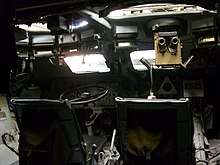
The Soviets modified the truncated cone turret used on the BTR-70 for the BTR-80 by redesigning the mantlet. This allows the 14.5 mm (0.57 in) KPVT and coaxial 7.62 mm (0.3 in) PKT machine guns to be elevated to a maximum of 60 degrees. This high angle of fire is useful in engaging targets on steep slopes, in urban fighting, and for engaging low slow flying air targets.[5] The Soviets had also modified the design and positioning of the firing ports; the ports are now round, rather than tear-shaped, and have ball mounts similar to those used on the BMP-1. The forward firing ports now sit in angled recesses, which allows infantry to fire to the front of the vehicle.
The redesigned side doors are split horizontally. The upper portion opens forward; this gives dismounting troops some protection against small arms fire from the front of the vehicle. The lower portion opens down, forming a step. Six smoke grenade projectors are mounted on the rear of the turret.
The BTR-80 can climb a slope with up to 60% gradient and climb a vertical step of 0.5 m.[6]
Remarks
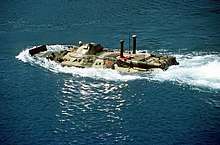
In 1984, the Soviets began production of a diesel-engined variant of the BTR-70, which they called the BTR-80. The Soviets have retrofitted some BTR-70s with several of the improvements incorporated into the BTR-80, including the high-angle-of-fire turret. The twin doors are designed to allow the infantry to disembark while the vehicle is in motion, and allow the infantry inside to exit from one side if the other is receiving fire. The 30mm Cannon variants are effective against most targets apart from main battle tanks, against which they can still cause significant damage to optics, weapons, and important systems. The main gun is not stabilized, so accurate fire on the move is limited to low speeds, and the turret's rotation mechanism is manually operated. The gunner sits in a roof-mounted chair located above the flat floor behind the driver/commander and two passengers, and before the passenger bench. The gunner's station is basic, but uncharacteristically spacious for a Soviet armored vehicle. The gunner is equipped with both a day time optical sight and an infrared night sight.
Versions
Russian Federation
.jpg)
- BTR-80 (GAZ-5903) – armoured personnel carrier.
- BTR-80K (GAZ-59031) (kommandnyj) – command vehicle APC with telescopic antenna mast, TNA-4 navigation device and R-163-50У series of radio equipment.
- BTR-80M – improved model with DMZ-238M2 engine of 240 hp, a slightly longer hull and new tires. In production since 1993. It is understood that only a small number were produced until the original engine was ready for production again.
- BTR-80A (GAZ-59034) – IFV (See pictures) with 2A72 30 mm gun and 300 rounds as primary weapon. The turret is called BPPU and is equipped with sights 1PZ-9 (day) and TPN-3 or TPN-3-42 "Kristall" (night). In production and service since 1994.[7]
- BTR-80S – variant of the BTR-80A for the Internal Troops of the MVD, equipped with a KPVT 14.5-mm machine gun and 7.62 mm PKT in the turret.
- BTR-80AK – command variant of the BTR-80A, with two whip antennas in the rear corners and with only one firing port on the right hull side.
- BRDM-3 (bronirovannaya razvedivatel’no-dozornaya mashina) – armoured reconnaissance/surveillance vehicle, based on the BTR-80AK and with a new day/night vision device in front of the commander's position. The crew consists of six men. Note that in some Western sources, the name BRDM-3 is incorrectly used for the 9P148 ATGM carrier.
- BTR-82 – latest production version with improved armour, spall liners, more modern night vision device TKN-4GA, GLONASS navigation system and a more powerful engine of 300 hp. The original armament is retained but is now installed in the BPPU turret of the BTR-80A/BTR-82A. The prototype of the BTR-82 was shown for the first time in November 2009.
- BTR-82A – latest production version with improved armour, spall liners, more modern night vision device TKN-4GA-02, 2A72 30 mm gun (a lighter, less complex cousin of the 2A42), GLONASS navigation system and a more powerful engine of 300 hp. The prototype of the BTR-82A was shown for the first time in November 2009. The Ministry of Defense of Russia has formally adopted the armored personnel carrier BTR-82A. The corresponding order was signed by Defense Minister Sergey Shoygu in early 2013.[8] In a Syrian government TV channel report, BTR-82A is seen in battle in Syria around September 2015. The video shows BTR-82A crew members speaking Russian. It is widely believed that Russian armoured vehicle units have been directly fighting anti-government groups in Syria.[9] Russia integrated the AU-220M Baikal remote turret[10] to the BTR-82A fitted with an autocannon firing the 57x348SR mm shells at 120 rpm.[11][12][13] The type tests of the updated BTR-82A armored personnel carrier have successfully been completed as of April 2019. Since 2019, all vehicles of the type will receive additional protection and a new fire control system with a thermal imager.[14]
- BTR-82AM – refurbished BTR-80 to the level of BTR-82A.[15][16] Distinguished by a closed (welded) embrasure in the frontal part of the vehicle.[16] The first batch was delivered in 2013. Used by naval infantry.[17]
- BTR-87 – Modification of the BTR-82A that relocates the engine compartment to the front-right part of the hull, allowing troops to disembark through rear and roof hatches.[18]
- BTR-82V – BTR-80 featuring hull upgraded to BTR-82A-level with 14.5 mm heavy machine gun in a manned turret. Development in accordance with terms issued by the Russian National Guard.[19]
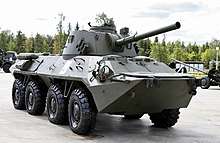
- 2S23 "Nona-SVK" – fire support vehicle with the 120 mm 2A60 rifled gun-mortar – developed on the base of 2А51 rifled gun/mortar of the 2S9 Nona – and a crew of 4. Adopted in 1990.[20]

- BREM-K (GAZ-59033) (bronirovannaya remontno-evakuatsionnaya mashina) – armoured recovery vehicle with towbars, a winch, welding equipment and a light crane.
- KM-80 or BTR-80 PBKM – command vehicle.
- RKhM-4 (razvedivatel’naya khimicheskaya mashina) – NBC reconnaissance vehicle with detection devices including the IMD-21BA and DP-5V, an automatic chemical alarm system GSA-12, a detection set for chemical agents KPKhR-3, an MK-3M meteo set, a KPO-1 sampling device, an ASP automatic detector and a KZO-2 flag dispenser to mark contaminated areas.
- RKhM-4-01 – improved version with more modern equipment, including the GSA-13, IMD-1R, ASP-12 systems, a PGO-11 semi-automatic detection device, R-171M and R-173M radios instead of the older R-123M.
- RKhM-4-02 – with upgraded detection systems such as the ASP-13, IMD-2NM and IMD-23, GSA-14; analysis, storage and interface unit UIK-RKhB and T-235-1U COMSEC equipment.[21]
- RKhM-6 "Povozka" – latest version with state-of-the-art detection systems, including the PRKhDD-2B with a detection range of about 3 km. Furthermore, the RKhM-6 is equipped with an SN-RKhM inertial navigation system and a 14Ts834 satellite navigation system.[21] In service since 2011.[22][23] Deployed to Syria in November 2018.[24]
- RPM-2 – mobile radiological reconnaissance station with KRPI system. In service since 2000. Might also be known as NKR (nazemnij kompleks radiatsionnoj razvedki, "ground nuclear recon complex").
- R-149BMRA – command and signals vehicle.
- R-145BM1 – 5-th generation command and signals vehicle. Entered service in 2015.[25]
- R-439-BK1 – SatCom station.

- "BPDM 15TS56M Tajfun-M" – new version for Strategic Rocket units (RVSN) developed on the basis of the BTR-82[26] that will replace the base security vehicles MBP on BTR-60/70 chassis. The BTR-80 version is equipped with a new turret with 7.62 mm machine gun, an unmanned aerial vehicle with a 5 km range, new optical and infrared bands observation device TKN-4S and a "Kredo-1" radar. In service since 2013. Over 30 vehicles were delivered since 2015.[27][28][29][30]
- ZS-88 (zvukoveshchatel’naya stantsiya) – PsyOps vehicle with loudspeaker set.
- ZS-96 (zvukoveshchatel’naya stantsiya) – PsyOps vehicle with loudspeaker set.
- K1Sh1 (GAZ-59032) – command post vehicle with bigger hull and unarmed turret. Also known as UNSh (unifitsirovannyj shassi, "unified chassis"). This version serves as the basis for several specialised vehicles, but Estonia used this type as an APC with a machine gun turret.
- BMM-80 "Simfoniya" (GAZ-59039) (bronirovannaya mnogofunktsionalnaya meditsinskaya mashina) – armoured ambulance, comes in three versions each of which can transport 9 patients, including two on stretchers on the rear hull (Developed in 1993):
- BMM-1 (first aid and evacuation from the battle field),
- BMM-2 (initial medical treatment at battalion-level) and
- BMM-3 (mobile field hospital).
- E-351BrM – mobile electric power station. The vehicle is equipped with an AD-30T/400 diesel-electric generator that can deliver power to up to 15 signals vehicles. It has a 2-men crew.
- PU-12M6 (9S482M6) (punkt upravleniya) – battery command vehicle (BKP – batarejnyj kommandnyj punkt) for air defence units equipped with "Strela-1M" (SA-9), "Strela-10M2 (SA-13), "Osa-AK" (SA-8), 2S6 "Tunguska" and ZSU-23-4 "Shilka".
- PU-12M7 (9S482M7) – improved version.
- 1V152 – command and forward observer vehicle for field artillery units. The standard equipment consists of range finders, day/night vision devices, navigation equipment etc. The 1V152 and 1V153 (on Ural-4320 truck) belong to the KSAUO "Kapustnik-B" set.[31][32]
- R-149BMR – signals vehicle, equipped with R-168-100KA "Akveduk-100KA", R-168-100U, R-163-25U, R-163-10V, and R-163-1V "Arbalet" HF/VHF radio sets, AVSK intercom, P-338 video system, AD-3,5U-28,5 generator, ASh-4 telescopic mast, AZI NVIS HF antenna and ShDA-50 Discone-type antenna.
- R-149MA3 – command and signals vehicle.
- BMM-80 "Simfoniya" (GAZ-59039) (bronirovannaya mnogofunktsionalnaya meditsinskaya mashina) – armoured ambulance, comes in three versions each of which can transport 9 patients, including two on stretchers on the rear hull (Developed in 1993):
.jpg)
- R-165B – HF signals vehicle equipped with "Arbalet-500K", R-163-10V and -50, R-163-AR radios, R-016V "Vishnya" HF link equipment and an AB-4U-P28.5-1V generator. The radio sets have a declared range of 20–350 km on the move and 40–1,000 km deployed.
- R-439-MD2 – SatCom station.
- R-439-BK "Legenda 2BK" – SatCom station,[33] operates within 3400-3900 MHz (reception) and 5725-6225 MHz (transmission) ranges.
- P-240BTZ – switchboard vehicle with "Zenit" set. Planned successor for the BTR-60 based P-240BT.
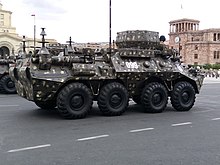
- "Infauna" – An electronic countermeasures variant created for the Airborne Troops; it is "designed to interfere with radio-controlled explosive devices ... as well as jamming the enemy’s tactical communications systems".[34] The VDV accepted the first four vehicles into active service in early July 2012 after completing field evaluation which started in early 2012.[35] As of September 2016, it has been delivered to Armenia.[36]
- Mars-2000 – Reconnaissance combat vehicle based on the BTR-82.[37][38]
- BTR-90
Colombia
- BTR-80 "Caribe" – version for Colombian marines with .50cal machine gun instead of 14.5 mm KPVT. 100 ordered. Caribe project is assembled in COTECMAR (Corporación Tecnológica del Mar Caribe) Plant in Cartagena de Indias, Colombia[39]
Estonia
- BTR-80 UNSh (EST) – Estonian version of the BTR-80. In 1992, about 20 armored vehicles were seized from a company trying to smuggle them out of Estonia as agricultural equipment. These vehicles were put into service in the Estonian Defence Forces.[40] In 2013, 13 vehicles were handed over to the Estonian Defence League.[41]
Hungary
- BTR-80M – Upgraded version with passive day/night sight KM-1M on top of the roof, stowage box for water bottles on the left hull side, improved NBC protection system and Kronsberg radio set.[42]
- BTR-80 GKKO – Turret-less version with observation equipment. Prototype.
- BTR-80 MPAEJ (műszaki páncélozott akadály elháritó jármű) – Unarmed combat engineer version without turret. In service.[43]
- BTR-80 MPFJ (műszaki páncélozott felderitő jármű) – Unarmed obstacle clearing vehicle without turret. In service.[44]
- BTR-80 MVJ (mentő-vontató jármű) – Repair and recovery vehicle with crane and winch. In service.[45]
- BTR-80 SKJ (sebesült kihordó jármű) – Much modified ambulance version with bigger troop compartment.[46]
- BTR-80 VSF (vegyi-sugár felderítő jármű) – NBC reconnaissance vehicle. In service.[47]
North Korea
- M2010 8×8 – Following the acquisition of 32 BTR-80As, North Korea appears to have produced and put into service a domestic clone of the vehicle of an unknown designation. It carries 3 crew and 7–8 troops and is fitted with an indigenous turret equipped with two 14.5 mm and one 7.62 mm machine guns. Other features such as protection, engine placement, entry and exit points, and amphibious capabilities are similar to the BTR-80.[48] It's known unofficially as the M-2010 or Chunma-D, since it first appeared in a military parade in 2010.[49]
- M2010 6×6 – North Korea also developed a 6×6 version of the BTR-80A to carry troops and cargo under armor and for reconnaissance. It carries 3 crew and 6 troops and is fitted with the same indigenous turret. There is a door on either side of the hull, and it otherwise has the same protection, engine placement, and amphibious capabilities.[50] It can also be fitted with a MANPADS launcher mounted on top of the turret.[51]
Peru
Romania

- TAB Zimbru (B33) (transportorul amfibiu blindat) – modified version of the BTR-80 with Model 1240 V8-DTS engine of 268 hp (197 kW), R-1231B radio set and 500 additional rounds 7.62 mm. Made by CN RomArm SA.
Ukraine
- BTR-80UP – improved version, produced in Ukraine in cooperation with Poland for Iraq (98 planned). Fitted with a new 300 hp engine, additional armour and air conditioner.[53]
- BTR-80UP-KB – battalion level command vehicle.
- BTR-80UP-KR – company level command vehicle.
- BTR-80UP-S – staff vehicle.
- BTR-80UP-M – ambulance.
- BTR-80UP-BREM – recovery vehicle.
- BTR-80UP-R – reconnaissance version.
- BTR-80UP-T – cargo version.
- BTR-94
- KShM "Kushetka-B" – command vehicle, based on the K1Sh1 chassis and developed by Radioprylad from Ukraine. The specialised equipment consists of the "Berkut-M" HF radioset and several, VHF sets – R-171M, R-173M "Abzats-M", R-163-50U, R-163-10V and R-163-1V "Arbalet" (with a range from 5 to 350 km). Other equipment includes a navigation apparatus (probably TNA-4-6), an AB-1-P28,5-B-V1 generator as well as DLYa4.115.002 and DLYa2.091.008 telescopic antenna masts.[54]
Operators

Current operators
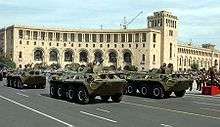

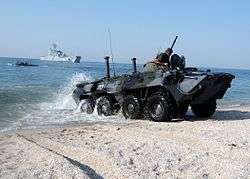
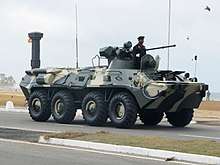




































Museum exhibits
References
- SPLA-N weapons and equipment, South Kordofan, December 2012 (PDF). HSBA Arms and Ammunition Tracing Desk. Small Arms Survey. February 2013. p. 11. Archived (PDF) from the original on 22 March 2016. Retrieved 2 January 2019.
- "Продукция - АМЗ". Archived from the original on 21 October 2014. Retrieved 26 November 2014.
- "История предприятия". Archived from the original on 28 August 2015. Retrieved 18 October 2015.
- "BTR-80A armoured vehicle personnel carrier technical data sheet specifications information pictures | Russia Russian army wheeled armoured vehicle UK | Russia Russian army military equipment vehicles UK". Archived from the original on 22 October 2018.
- Zaloga 1990: "The turret on the BTR-80 uses a new trunnion mounting which gives greater elevation for firing at enemy helicopters."
- ARG. "BTR-80 Armored Personnel Carrier". Military-Today.com. Archived from the original on 11 October 2011. Retrieved 15 July 2013.
- http://www.army-technology.com/projects/btr80/ Archived 25 March 2009 at the Wayback Machine
- "BTR-82A adopted". Archived from the original on 2 August 2013. Retrieved 26 November 2014.
- "BTR-82A joins Syrian civil war". Archived from the original on 12 September 2015. Retrieved 8 September 2015.
- "Russian BTR-82 armoured personnel carrier could be upgraded with AU-220M turret 57mm cannon TASS 10810161 | weapons defence industry military technology UK | analysis focus army defence military industry army". Archived from the original on 30 March 2019.
- BTR-82A Armored Personnal [sic] Carrier to receive anti-tank gun Archived 22 August 2016 at the Wayback Machine – Armyrecognition.com, 19 August 2016
- "BTR-82A Armoured Personnel Carrier - Army Technology". Archived from the original on 22 October 2018.
- "Archived copy". Archived from the original on 25 November 2018. Retrieved 25 November 2018.CS1 maint: archived copy as title (link)
- "Archived copy". Archived from the original on 18 April 2019. Retrieved 18 April 2019.CS1 maint: archived copy as title (link)
- "BTR-82A BTR-82AM Armoured infantry fighting vehicle". Armyrecognition.com. Archived from the original on 15 October 2014. Retrieved 7 February 2015.
- Берзов, Сергей (7 September 2014). Российский телеканал по ошибке опубликовал видео уничтоженного бронетранспортера БТР-82АМ [Russian TV-channel unintentionally published video of a destroyed BTR-82AM]. Military-Informant.com (in Russian). Archived from the original on 7 February 2015. Retrieved 7 February 2015.
- "BTR-82AM Amphibious Armoured Personnel Carrier (APC), Russia". army-technology.com. Kable. Archived from the original on 7 February 2015. Retrieved 7 February 2015.
- Russia to upgrade its BTR-82A armoured personnel carrier to BTR-87 Archived 7 November 2016 at the Wayback Machine – Armyrecognition.com, 24 March 2016
- Russian company VPK introduces its BTR-82V armored personnel carrier Archived 11 December 2017 at the Wayback Machine – Armyrecognition.com, 8 December 2017
- "Archived copy". Archived from the original on 2 August 2013. Retrieved 2 August 2013.CS1 maint: archived copy as title (link)
- "«ЗАВОД ТУЛА" (PDF) (Press release). ОТКРЫТОЕ АКЦИОНЕРНОЕ ОБЩЕСТВО. Archived (PDF) from the original on 16 August 2011. Retrieved 15 July 2013.
- "ЦАМТО / Новости / В 2011 году в Сухопутные войска в рамках гособоронзаказа поступило более 30 РСЗО «Торнадо-Г»". www.armstrade.org. Archived from the original on 1 January 2017. Retrieved 1 January 2017.
- "ЮВО России: войска РХБ защиты перевооружаются на современные мобильные комплексы". Archived from the original on 12 November 2013. Retrieved 26 November 2014.
- "Archived copy". Archived from the original on 17 November 2018. Retrieved 17 November 2018.CS1 maint: archived copy as title (link)
- "Связисты ЮВО провели радиотренировку в Чечне - Еженедельник "Военно-промышленный курьер"". vpk-news.ru. Archived from the original on 22 October 2016. Retrieved 21 October 2016.
- "Archived copy". Archived from the original on 24 September 2018. Retrieved 24 September 2018.CS1 maint: archived copy as title (link)
- "ТАСС: Сибирь - В Новосибирской области соединения РВСН успешно отразили действия условного противника". ТАСС. Archived from the original on 16 September 2014. Retrieved 26 November 2014.
- "РВСН испытали боевого робота-охранника с гранатометом". 10 November 2016. Archived from the original on 13 November 2016. Retrieved 12 November 2016.
- "Archived copy". Archived from the original on 18 January 2017. Retrieved 18 January 2017.CS1 maint: archived copy as title (link)
- https://armstrade.org/includes/periodics/news/2020/0403/103057358/detail.shtml
- "Капустник-Б", автоматизированная система управления огнем ствольной артиллерии, минометов и реактивных систем залпового огня — ОРУЖИЕ РОССИИ, Федеральный электронный справочник вооружения и военной техники Archived 3 July 2012 at WebCite
- лБРХУФОЙЛ-в :: чойй "уЙЗОБМ" Archived 11 July 2004 at the Wayback Machine
- "ЦАМТО / Новости / В Приамурское объединение ВВО поступили новые мобильные станции спутниковой связи". armstrade.org. Archived from the original on 22 August 2017. Retrieved 22 August 2017.
- Sputnik. "Russian Airborne Gets New ECM System". en.rian.ru. Archived from the original on 7 October 2012. Retrieved 6 July 2012.
- "Infauna". www.deagel.com. Archived from the original on 12 April 2013. Retrieved 2 August 2013.
- "ЦАМТО / Новости / Военный парад, посвященный 25-летию независимости Армении, прошел 21 сентября в Ереване". www.armstrade.org. Archived from the original on 28 July 2017. Retrieved 23 September 2016.
- "Russia developing new reconnaissance armored vehicle". tass.com. Retrieved 27 May 2020.
- "Mobile reconnaissance point PRP-5". www.snafu-solomon.com. Retrieved 23 June 2020.
- Colombia: Seguridad y Defensa Archived 24 September 2006 at the Wayback Machine
- Abel, Urmas (2017). "Vene sugemetega soomukid sõitsid taas Eesti pinnal". Sõdur (in Estonian). No. 4. p. 18. ISSN 1406-3379.
- Andersen, Ardi (2014). "Kose meeste oma BTR". Kaitse Kodu! (in Estonian). No. 4. p. 58. ISSN 1406-3387.
- eredmeny Archived 7 February 2008 at the Wayback Machine
- "BTR-80 MPAEJ", currus.hu (in Hungarian), archived from the original on 7 February 2008
- "BTR-80 MPFJ", currus.hu (in Hungarian), archived from the original on 7 February 2008
- "BTR-80 MVJ", currus.hu (in Hungarian), archived from the original on 7 February 2008
- "BTR-80 SKJ", currus.hu (in Hungarian), archived from the original on 7 February 2008
- "BTR-80 VSF", currus.hu (in Hungarian), archived from the original on 7 February 2008
- North Korean 8x8 APC Archived 9 April 2016 at the Wayback Machine – Military-Today.com
- "North Korean M-2012 8x8 APC derived from BTR-80". www.massimotessitori.altervista.org. Archived from the original on 13 March 2017. Retrieved 1 April 2017.
- North Korean 6x6 APC Archived 9 April 2016 at the Wayback Machine – Military-Today.com
- Analysis: New combat vehicles and tanks at military parade in North Korea by Army Recognition Archived 18 April 2017 at the Wayback Machine – Armyrecognition.com, 17 April 2017
- https://web.archive.org/web/20140828225053/http://discasanave.com/index.php?option=com_content&view=article&id=54&Itemid=300025
- Altair – R-wto 12/2006 – BTR-80UP do Iraku. Sokoły chyba nie Archived 22 July 2012 at Archive.today
- Военная кафедра МТУСИ :: Командно-штабная машина "Кушетка-Б" на транспортной базе БТР-80 Archived 6 March 2008 at the Wayback Machine
- Christopher F. Foss. Jane's Tanks and Combat Vehicles Recognition Guide (2000 ed.). Harper Collins Publishers. pp. 410–414. ISBN 978-0-00-472452-2.
- "Trade Registers". Armstrade.sipri.org. Archived from the original on 14 April 2010. Retrieved 20 June 2013.
- IISS (2007). The Military Balance 2007. London: Routledge for the IISS. p. 155. ISBN 978-1-85743-437-8.
- "Archived copy" (PDF) (in Russian). Archived from the original (PDF) on 29 November 2014. Retrieved 23 November 2014.CS1 maint: archived copy as title (link).
- https://www.csis.org/analysis/russian-engagement-latin-america-update
- "Archived copy". Archived from the original on 17 July 2015. Retrieved 12 April 2014.CS1 maint: archived copy as title (link) БТР-80 в Сирии
- "Panssarimuseon kesä 2011" (PDF) (Press release). panssarimuseo. 2011. Archived from the original (PDF) on 20 July 2011. Retrieved 15 July 2013.
Sources
- Zaloga, Steven J. (1990). Soviet Wheeled Armored Vehicles. Hong Kong: Concord Publications. ISBN 962-361-013-0.
- Hull/Markov/Zaloga (1999). Soviet/Russian Armor and Artillery Design Practices: 1945 to Present. Darlington Productions. ISBN 1-892848-01-5
- UN register of conventional arms
External links
| Wikimedia Commons has media related to BTR-80. |